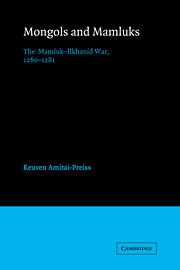Book contents
- Frontmatter
- Contents
- List of illustrations
- Preface
- List of abbreviations
- Notes on dates and transliteration
- Introduction
- 1 The historical background
- 2 The battle of ʿAyn Jālūt
- 3 The formulation of anti-Īlkhānid policy
- 4 The search for a second front
- 5 Military and diplomatic skirmishing
- 6 The secret war
- 7 Baybars's intervention in Seljuq Rūm
- 8 Baybars's posthumous victory: the second battle of Homs (680/1281)
- 9 The Mamluk–Īlkhānid frontier
- 10 Mamluks and Mongols: an overview
- Maps
- Genealogical Tables
- Glossary
- Bibliography
- Index
9 - The Mamluk–Īlkhānid frontier
Published online by Cambridge University Press: 23 November 2009
- Frontmatter
- Contents
- List of illustrations
- Preface
- List of abbreviations
- Notes on dates and transliteration
- Introduction
- 1 The historical background
- 2 The battle of ʿAyn Jālūt
- 3 The formulation of anti-Īlkhānid policy
- 4 The search for a second front
- 5 Military and diplomatic skirmishing
- 6 The secret war
- 7 Baybars's intervention in Seljuq Rūm
- 8 Baybars's posthumous victory: the second battle of Homs (680/1281)
- 9 The Mamluk–Īlkhānid frontier
- 10 Mamluks and Mongols: an overview
- Maps
- Genealogical Tables
- Glossary
- Bibliography
- Index
Summary
The entire population of some provinces, because they were frontier [regions] and were traversed by armies, was either killed or fled, such a s … parts of Abulustayn and Diyār Bakr: thus Ḥarrān, Ruḥā, Sarūj and Raqqa, as well as most of the cities on this and that side of the Euphrates, were completely uncultivated and abandoned.
Rashīd al-DīnThe frontier region
In this section, a number of generalizations will be drawn about the nature of the Mamluk–Īlkhānid frontier. Much of the discussion will be based on the findings in chapter 5, in which the course of the border war was examined in some detail. Each kingdom's frontier, its defence and the strategy adopted towards the other side will be examined separately.
The Mamluk border defence was based first on the two great fortresses on the bank of the Euphrates, al-Bīra and al-Raḥba. During Baybars's reign, the former was more prominent, as it suffered most of the Mongol attacks. It withstood every attack and siege attempt, in no small degree thanks to the Sultan's prompt dispatch of relief. These forts were well supplied and garrisoned, and were connected to the center of the Sultanate by several means of rapid communication (barīd, pigeon-post and bonfires). Al-Bīra and al-Raḥba served several important functions: they guarded the fords, served as forward-warning stations and would withstand the first shock of a Mongol offensive. In addition, they acted as centers for the gathering of intelligence on the Mongols, and as bases for raids into Mongol-controlled territory.
- Type
- Chapter
- Information
- Mongols and MamluksThe Mamluk-Ilkhanid War, 1260–1281, pp. 202 - 213Publisher: Cambridge University PressPrint publication year: 1995
- 1
- Cited by

